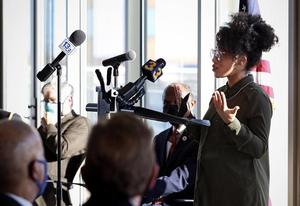By Hampton University
Hampton University alumna Ashley Montgomery ’19, who earned her master’s of architecture at Franklin W. Olin School of Engineering and Technology, served a leadership role on the technical advisory committee for the first Virginia Coastal Resilience Master Plan, which was released yesterday.
“Congratulations to Ms. Ashley Montgomery on her involvement and leadership role with the Virginia Coastal Resilience Master Plan,” said Hampton University President Dr. William R. Harvey. “Ms. Montgomery is a prime example of what Hampton University strives to do. We help provide our students world-class education, who then make a positive impact on the community.”
Montgomery led the outreach and engagement subcommittee, which focused on community engagement and inclusion in the planning process. The Virginia Coastal Resilience Master Plan, a multi-year effort, is the first full coastal technical assessment study for all of Coastal Virginia. The plan includes predictive flood hazard mapping — storm surge and tidal flooding — for the year 2080. It also includes an assessment of how critical infrastructure will be affected by that flood hazard.
“What’s most important about this plan is we begin to build that answer with Virginians — our neighbors, our community members, business owners — especially our historically disinvested communities,” Montgomery said. “We made a decent start to this engagement, and need to continue effort. These voices are necessary in crafting that answer for a future envisioned for everyone.”
As a student at Hampton University, Ashley was a student leader for the Coastal Community Design Collaborative, an interdisciplinary team of architects, engineers, marine biologists, and communicators who developed innovative designs for managing water in Hampton Roads neighborhoods. She was also a recipient of Virginia Sea Grant’s Future Resilience Leader Award.
“She is well known to localities across Hampton Roads for her work at Hampton University and with Old Dominion University for the Coastal Communities Design Collaborative,” said Rear Admiral (Retired) Ann C. Phillips, Special Assistant to the Governor for Coastal Adaptation and Protection.
Currently, Montgomery serves as an associate designer at Hanbury, a firm focused on planning, architecture, and interior design. There, she incorporates climate change into her design work by striving to understand the communities for design sites and creating structures that work with the natural environment.
The Commonwealth intends to develop successive updates of the Master Plan on at least a five- year cycle, managed by the Department of Conservation and Recreation in consultation with the Chief Resilience Officer, the Special Assistant to the Governor for Coastal Adaptation and Protection, and the Technical Advisory Committee.
“This is truly a milestone for Virginia, and it will set the course for us to adapt and protect our most critical natural, economic, and social infrastructure,” said Governor Ralph Northam.
“Nearly four years ago, when the Commonwealth began developing this document, we knew Virginia had a long way to go to adapt to coastal flooding. We now have a clearer picture of the scope and scale for today and tomorrow.”
The next phase of the Master Plan is anticipated by 2024, will aim to address recommendations of the technical advisory committee to broaden the analysis of natural hazards by including rainfall-driven, riverine, and compound flooding, expand and improve the inventory of resilience projects. by continuing to add efforts and working with project owners to better understand the benefits of projects, and extend this critical work beyond the coastal region to encompass statewide resilience needs.





